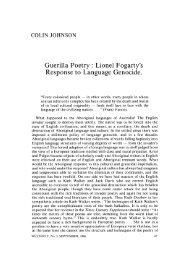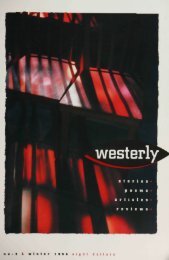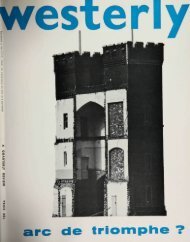a highly ambivalent attitude to his country, and to art, and to his own role as animaginative artist, and so he soon succumbed, developing an enthusiasm for his newrole which was to endure for the rest of his life. Fifteen years later, after the FirstWorld War had interrupted his plans, partly by sending many of his fellow writersback to Europe in uniform, Esson returned to the scene of his inspiration for moredetailed practical advice on how. actually to establish the company. He then wentback to Melbourne and, with his· friends, established one.The Pioneer Players was not a success and Esson's own writing slowed and allbut stopped, perhaps in response. Yeats died in the dead of the winter, which wasof course summer over here, with all his glory on him, but Esson died, nearly fiveyears later, in the dead of an Australian summer, a sad and disillusioned man whohad failed, as his lifelong friend Vance Palmer put it, ever to express himself fullyin his work. It was Esson's devotion to the charismatic leadership of Yeats and tothe dramatic model of Synge and the theatrical model of the Abbey Theatre which,more than any other single factor, caused this failure. Even in 1905 Yeats and Syngewere fighting their own battles, and their particular brand of spiritUal nationalismwas soon to provoke strong negative reactions from their audiences and their fellowtheatre-workers, and, in Yeats' case, from his beloved. They little realised, as theygave their advice to their young visitor from the colonies, how spectacularlyinappropriate it was for Australia. No more, for that matter, did Esson, or at least,if he did, he suppressed the realisation.There were disguised internationalist and 'universalist' motives underlyingAustralian literary nationalism in the early years of this century. Nationalism wasthen an international phenomenon. In drama and theatre the contemporaryexamples of America and Russia were important, as were the historical examplesof Ancient Greece, Elizabethan England, and, in the conversations between Yeatsand Esson, 18th century Venice and Robbie Burns' Scotland. Nationalist art, forEsson and for many of his fellow writers, was seen partly as a way to internationalrecognition, and the key which might gain Australia admission to the great templeof Apollo - universal art.This was the basic problem in Esson's career. He was a writer and critic withsophisticated taste and an interest in the advanced modernist literature of his time,who, under the influence of his Irish mentors, turned his energies towards theestablishment of a simple folk theatre. He was a nationalist who drew his inspirationfor a distinctively Australian literature from a bewildering array of models fromoverseas.There were other conflicts which Esson never managed to resolve as Yeats resolvedhis. Esson was obsessively interested in the theatre at a time when there were notheatres in Australia performing Australian material. He was a romantic who feltcompelled to turn away from romance and occupy himself with the everyday realitiesof his characters' lives. He displayed early a talent for the witty mannered comedywhich was in his time popular on the commercial stage but he turned angrily againstthat style and devoted himself to forging a style of simple folk realism. As VancePalmer wrote, what inner contradictions he had to resolve before he wrote a linePLike Yeats Esson had to resolve contradictions on a personal level also. He wasa lonely, initially timid man who craved the gregarious life of the theatre. He lovedthe conversation and companionship of a literary circle, and longed for the sort ofartistic community he observed in London and Paris, but he felt obliged continuallyto hide himself away in the bush, seeking inspiration for his folk theatre. He wasa sceptic, a bohemian, a Wildean socialist with spiritUal yearnings which, unlikeYeats, he never satisfied. His spiritUality was suppressed and diverted into a lovefor the picturesque and the exotic and in an almost holy reverence for what he hopedwould become the great Australia Felix. This was itself suppressed and controlledby his ruthless search for folk realism in his writing. Frank Dalby Davison called34 WESTERLY, No.2, JUNE, 1989
him a 'dweller in a Celtic twilight'2 and if that was an unfortunate place to dwell,in Ireland during the Troubles, then it was even less appropriate in Australia in theearly decades of this century.The fmal irony is that Esson was a nationalist who needed a heroic model andthat he didn't find one in Australia. After an initial dislike he came to have greatrespect for Henry Lawson, who achieved in the short story a great deal of whatEsson hoped to achieve in drama, including the international recognition, butLawson was never a friend or a personal role model. The nationalist Australian poetBernard O'Dowd was a strong influence on him early in his career, as was, later,the American playwright Eugene O'Neill, but Esson found his strongest personalinspiration in the charismatic leadership of William Yeats and his artistic modelin John Synge.These conficts and the personal doubts which they engendered pervaded all ofEsson's work and his relationship with Yeats and the Irish model. They were doubtsand conflicts which he never resolved.* * *Esson only personally met Yeats twice, on two separate trips to Europe whichtook on for him the character of pilgrimages. His excitement over meeting the greatpoet was partly simply the result of Yeats' flattering interest in him. Especially onthe second trip, in the early 1920s, Esson was very excited that the great Irishmanhad read some of his published one-act plays and sought him out.Yet another ironic reflection of the international base of Esson's nationalism wasthe fact that he kept meeting his key Irish mentors everywhere but in Ireland. Onhis first trip, in 1904, before he had begun to write plays at all, he attended a receptiongiven by Lady Gregory after a performance of the Irish Players in London. Therehe met John Masefield who invited him to dinner in his rooms to meet Synge. Essonand Synge discussed art and literature and literary nationalism until 2 o'clock inthe morning. Walking home together down the Edgware Road to Bloomsbury,Synge, who had at that time published no plays but had had Riders to the Seaand The Shadow of the Glen produced, revealed that he was writing a full-lengthplay. He invited Esson to Dublin to see the Abbey Theatre and to attend somerehearsals. The play turned out to be The Well of the Saints, which along with TheTinker's Wedding, had a great influence on Esson when he came to write VagabondCamp. 3Esson duly travelled to Paris, still in pursuit of the bright lights of Montmartre.He was living there when a note came from Synge confirming the dates, to Dublin.He attended the opening performance at the Abbey Theatre, in late December 1904,where he saw Yeats' On Baile's Strand, Lady Gregory's Spreading the News anda revival of the play which began it all, Yeats' Cathleen Ni Houlihan. He was rathershocked to find that the threatre was so tiny, so distant from the centre of Dublin,and that the audiences, even at the opening, were rather small. 'Even at that time',he wrote many years later, 'I had no doubt that the Abbey was the most importanttheatre in the English speaking world.' He was also conscious of the difficult taskon which the Abbey was engaged, in a philistine country, like his own:There never was an art-loving nation, so Whistler maintained; and when the curtain fellon one of the plays, I heard a young man remark: "I don't know if Ireland can be savedby Symbolist drama!'"He does not say but this was presumably one of the Yeats plays. Perhaps Essontook the comment to heart, for although he took Yeats' practical advice and wasinspired by Yeats' personality, he took Synge as his dramatic model.WESTERLY, No.2, JUNE, 1989 35
- Page 3 and 4: CONTENTSWESTERLYVOLUME 34, No.2, JU
- Page 5: WESTERLYa quarterly reviewISSN 0043
- Page 8 and 9: JAN KEMPTo My Father, M.H.K.My fath
- Page 10 and 11: JAN KEMPThe GypsySuddenly before yo
- Page 12 and 13: WONG PHUI NAMA Death in the WardThe
- Page 14 and 15: WONG PHUI NAMCousinI had to call to
- Page 16 and 17: WONG PHUI NAMObitIt is as thin smok
- Page 18 and 19: So thus I lie here fearful of movem
- Page 20 and 21: VIRGINIA BERNARDA ValedictionWhen N
- Page 22 and 23: "Yeah, yeah," I call, returning the
- Page 24 and 25: she flops for a bit, slurps her tea
- Page 26 and 27: well her students did, she was neve
- Page 28 and 29: English or Indian, that they had th
- Page 30 and 31: ANDREW TAYLORSpringSpring is a dive
- Page 32 and 33: CAROL SElTZERAiming for the MouthTr
- Page 34 and 35: GRAEME WILSONA Selection of Japanes
- Page 38 and 39: Esson attended some rehearsals of T
- Page 40 and 41: the literary life of Bloomsbury. Lo
- Page 42 and 43: Without Yeats Esson would quite lik
- Page 44 and 45: "What theatre do you have in Austra
- Page 46 and 47: In the back room Esson could feel t
- Page 48 and 49: "When we started our little theatre
- Page 50 and 51: a screen against a wall. A theatre
- Page 52 and 53: VINCENT O'SULLIVANSinging Mastery:
- Page 54 and 55: flighty relation in most statements
- Page 56 and 57: living and the dead; that places hi
- Page 58 and 59: quite diverse traditions towards th
- Page 60 and 61: WARRICK WYNNEThe Wetlands (for Liam
- Page 62 and 63: JAN OWENSmileOur mother aimed the b
- Page 64 and 65: RICHARD KELLY TIPPINGOlympic Airway
- Page 66 and 67: DAVID REITERBear by the Jasper Road
- Page 68 and 69: (At twenty eight you did not bother
- Page 70 and 71: left, would have risen and walked o
- Page 72 and 73: He had hair like mine used to be, t
- Page 74 and 75: OLIVE PELLThe QuestionTell me how t
- Page 76 and 77: BRIAN MOONANAT 515: MASS LECTURE Th
- Page 78 and 79: PETER KIRKPATRICKTear HereThe bay i
- Page 80 and 81: JOHN WINTERThe Bird ManIn wooded, p
- Page 82 and 83: KNUTE SKINNERAugust 15There's a lig
- Page 84 and 85: M.E. PATTI WALKERThe Hook"Aren't yo
- Page 86 and 87:
QMNQMNQMNQMNapartheid man, this is
- Page 88 and 89:
QMNQMNQMNeasy because you don't bel
- Page 90 and 91:
lands or which have been taken over
- Page 92 and 93:
GEOFF GOODFELLOWToo MuchDianne is 1
- Page 94 and 95:
SHANE McCAULEYSouth Fremantle, Summ
- Page 96 and 97:
JEAN KENTWaiting Out the DroughtWai
- Page 98 and 99:
STEPHEN MAGEEJesus Falls, South Aus
- Page 100 and 101:
SIMON BROWNBlue Hole, Santothe colo
- Page 102 and 103:
CONAL FITZPATRICKA Brown Dog, Off A
- Page 104 and 105:
PAUL HETHERINGTONOne RoomIn teeming
- Page 106 and 107:
society, or, in the terms of the my
- Page 108 and 109:
emphasised (I think) in the referen
- Page 110 and 111:
Summer Leaves". This continues the
- Page 112 and 113:
Deficiency Bill in Western Australi
- Page 114 and 115:
invocation of pastoral near the beg
- Page 116 and 117:
particularly dreaded). The final re
- Page 118 and 119:
VINCENT O'SULLIVAN - is one of New







